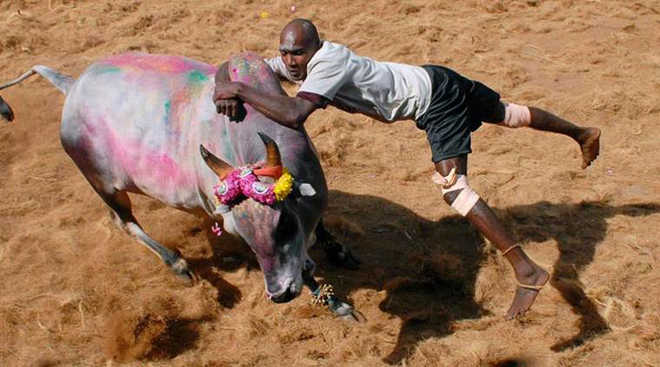Following huge protests on the Marina Beach and elsewhere in Tamil Nadu against the ban on jallikattu last week, the government caved in to popular pressure and found a way again to not take the bull by the horns (to tackle a problem decisively). So, as of now, even as animal lovers challenge the continuation of the bull-taming sport in the court, the traditional game is held during the Pongal festivities for the past about 2,500 years. A seal of the Indus Valley Civilisation depicting a man and a bull is believed to portray this game.
Jallikattu literally means "bull embracing". It is derived from salli (coins) and kattu (package). Kattu refers to a bundle of coins or gold that is tied to the bull's sharpened horns. The bull is released into a crowd and participants attempt to pluck this prize by stopping the running bull by hanging on to its huge hump in front of spectators, awestruck by the entertainment.
Those in favour of jallikattu argue that it's a tradition that must be allowed to continue as it helps in the continuation of the particular breed of bull which is facing depletion in numbers and extinction. However, it fails to cut ice with me or hit the bull's-eye of my reasoning. The sport involves torture of the animal and the participants risk injury and even being gored to death. Unlike the ancient times, don't we today have other enough means of entertainment? Incidentally, the one and only time in modern Olympics when live pigeon shooting was an event was in the 1900 Games. And ever since, but for the equestrian events, animals are not part of any sport.
I wonder that in our country, where the cow is held sacred and given respect equal to that of a mother, how such use of a bull is permitted. Surely, if the bull were able to more than just moo, it would moo: “Gender discrimination!”
A similar debate has been raging in Spain over matadors and bullfighting. It reminds me of my Spanish classes wherein as part of the course on Spanish culture, we were told about matadors. Having only a romantic notion of the brave and heroic matadors, mostly derived from films, I was shocked to know that matador in Spanish means “slayer, killer” (in English, matador is generally referred to as the bullfighter). In their corrida de toros (literally, running of the bulls), the man (women matadors traditionally are discouraged and frowned upon) is expected to kill the bull with his skill.
As a philozoic (having tenderness for animals), I feel that such activities must be stopped. They must be relegated to our history, become old and obsolete practices. All ailurophiles (those who love cats) and cynophiles (those who fancy dogs) would agree with me, definitely. It’s so good that today we mostly talk of hunting, poaching, fishing, circus shows, bear-dancing, monkey tricks, parrot-talking, snake-charmers etc in the past tense.
During a visit to the Sukhna Lake in Chandigarh, I was relating to my little niece of the time when people sitting with a fishing rod dipped in the waters was not an uncommon sight there, complete with the patient wait for the bait catching the prized catch. Or, the pleasure we derived from watching the huge black woolly bear dancing to the drum of his master and ditto with the monkeys making moves around a story even as all neighbourhood kids got attracted to the street shows like rats to the Pied Piper. She looked at me with eyes full of awe, perhaps unable to grasp the idea of a dancing animal outside of the ipad or smartphone!
And recently, I got a past tense story for myself too. A tiger occupied the pride of place on the wall of a friend’s drawing room! Yes, the skin of a real tiger pinned to the wall and its face sitting on the mantle with stones for eyes stared serenely at one and all. My friend proudly told me that it had been there for over sixty years when her grandfather brought it home. And, that was not all. Pointing towards a corner, she added that those days of hunting and trading in animals had yielded for them their side table. To my wonder and amusement, I was informed that the table leg was an elephant’s paw, adorned by a brass ring and topped with a flat wood piece. No cock and bull stuff!
By the way do you know why elephants have wrinkles? Because they increase the pachyderm's surface area. A tusker weighing around two tonnes has around 1,12,000 square centimetres of skin. This floppy hide releases heat which is essential for the elephant's survival in the hot climate. And when the animal is having a dust bath, it is doing so to clean it of the parasites that lodge themselves on it. When the sand dries, it scrapes them off by rubbing itself against a tree.
hkhetal@gmail.com
Unlock Exclusive Insights with The Tribune Premium
Take your experience further with Premium access.
Thought-provoking Opinions, Expert Analysis, In-depth Insights and other Member Only Benefits
Already a Member? Sign In Now










